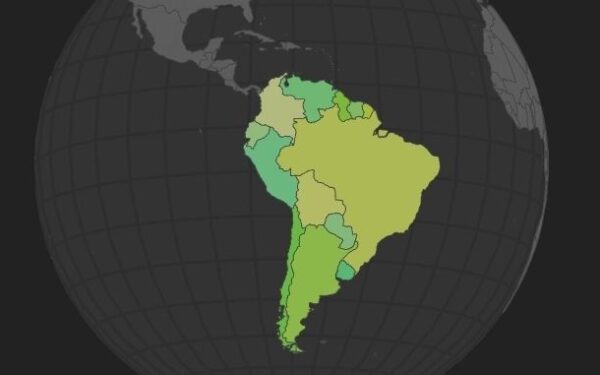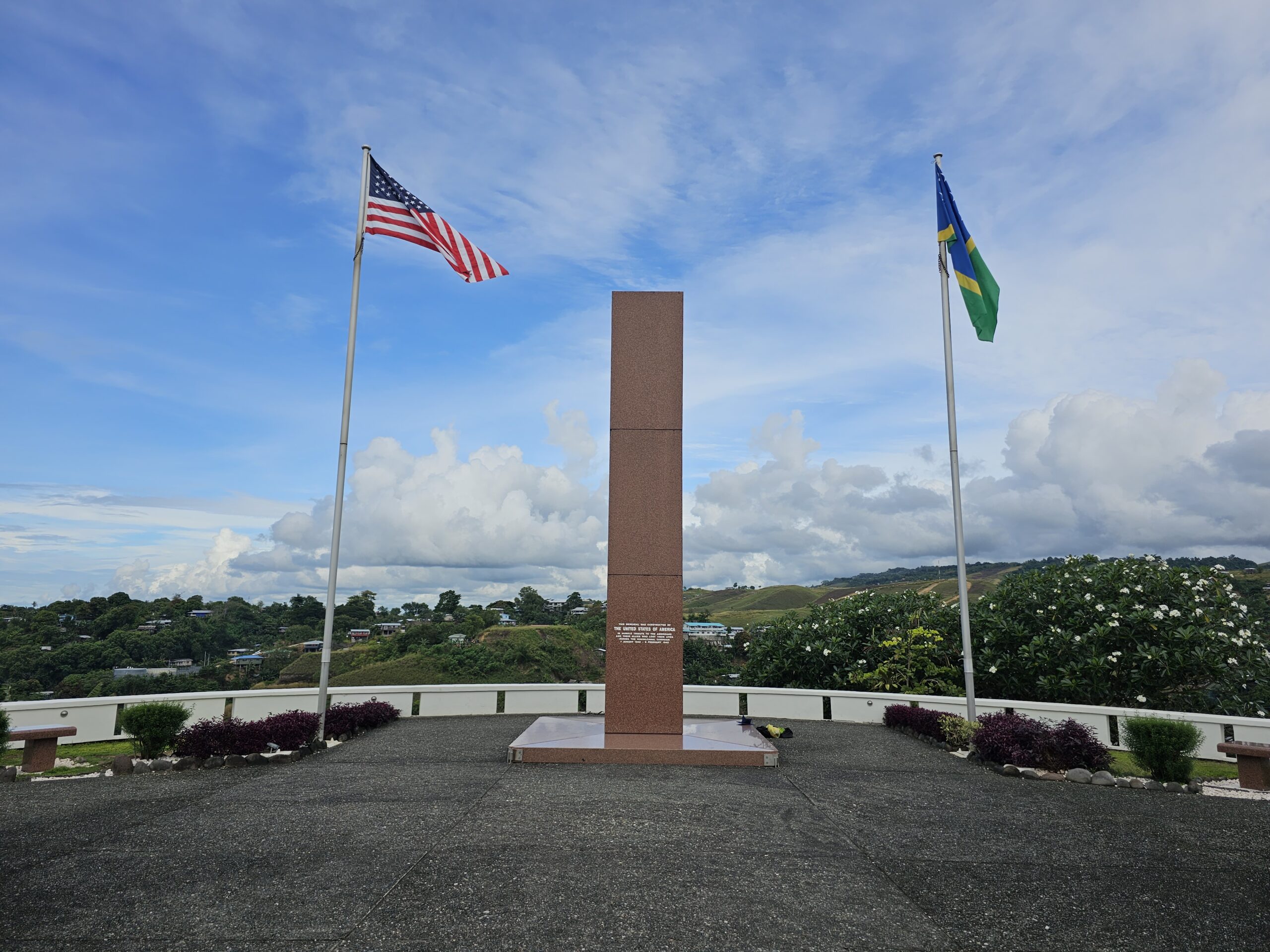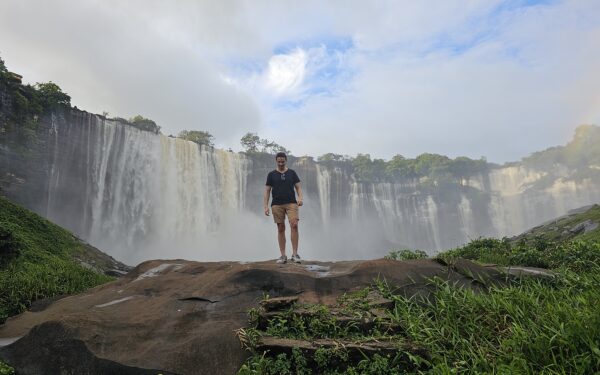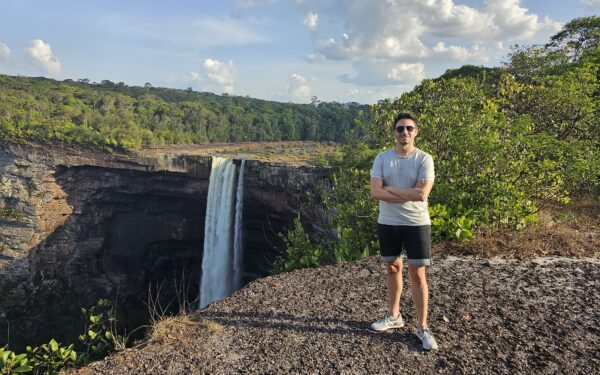Travel Report: Ecuador
Date of visit: December 2018
Nope, the trip to Ecuador didn’t start well…
Tobi, Jasmin and I almost missed the flight to Ecuador. We had booked a flight from Medellin to Quito via Bogota. Both flights were with Avianca, and we had 2.5 hours for the transfer in Bogota. Unfortunately, the first leg from Medellin to Bogota had a delay of one hour and forty minutes, so we had only 50 minutes to change the plane.
The next problem was that we had to exit the airport, as we arrived on a domestic flight, and needed to go through immigration afterwards. I cannot remember if I had ever run such a distance at any airport in the world, but I could barely breathe anymore when I arrived at the gate. If the flight from Medellin to Bogota would have arrived five minutes later, we would have missed the flight to the Ecuadorian capital.
Imprisoned in the “criminal mountain village”
The journey to Ecuador was not the best, but it didn’t get better when we arrived in Quito.
We arranged a pickup from our hostel and the 50-year old driver thought it would be a good idea to bring his lovely wife with him. As a consequence, the three of us were sitting in the back of a tiny car like tightly canned sardines while driving through the dark streets from the airport to the city center.
45 minutes later, we arrived at our hostel in Quito’s old town. The guy at the reception looked like the Latin version of a Big Bang Theory-character. You could see from his face expression that he was motivated to do everything other than welcoming new guests.
“Do you speak English?” we asked. “Not so good. It’s 10% more if you pay by credit card,” he answered. Nice. We landed in Ecuador at 22.30 and just wanted to go to our hostel after an exhausting travel day. Therefore, we didn’t withdraw money at the airport.
“Is there a shop nearby? We need to buy some stuff.” Jasmin asked. “Everything is closed,” was the unhelpful answer of Latin American Sheldon Cooper. “How do you mean everything is closed? It’s Saturday night!” – “Everything nearby is closed.” – “Ok, how long does it take if we walk to the next shop?” – “You cannot walk. It’s too dangerous.”
Latino Sheldon took us to our small and also very cold room. Quito is the highest capital in the world with an elevation of 2,850 meters. That means it gets pretty cold at night. Some might claim that La Paz is the highest capital city in the world, however, La Paz is only Bolivia’s government seat. Bolivia’s constitutional capital is Sucre.
The hostel had a nice terrace, where we found three other travelers, two from Germany and one from India. We told them what the guy at the reception just said about the safety situation. He was apparently telling the truth. “A female traveler got attacked here two days before, when she left the taxi and wanted to enter the hostel,” on of the Germans said.
Tobi shook his head: “We have been traveling through South America for almost two months now! We have been to cities like Buenos Aires, Rio de Janeiro, Medellin, and now they are telling me that this mountain village is too dangerous to walk around at night?!?”
Two minutes later, Latino Sheldon arrived in order to send us to bed. Seriously, I am telling the truth. He was telling us that the terrace was closed now. So was the front door of the hostel and that meant that we had to go to our rooms. I ended up in Tobi’s and Jasmin’s room for one last beer before I went to bed.
Fortunately, we had to get up early the next day. So it was not a problem that we were imprisoned in our room and couldn’t do anything anymore. Not being able to leave the hostel at night was still something completely new to me. 80 countries and a new debut. In Ecuador.
Quito to Baños
Ten hours later, we were standing in Quito’s chaotic bus terminal. To be honest, I didn’t know a lot about Ecuador when I decided to add the country to my South America itinerary. My original plan was spending two nights in Quito and five on the Galapagos.
The closer the trip came, the more I realized how many beautiful places you can find in Ecuador, and I regretted that I only had seven days for the country. Therefore, I cut my last day in Medellin and skipped the night in Cali so that I had two additional days in Ecuador. It was still not enough, but it gave me the opportunity to see one more place at least. Baños should be that place.
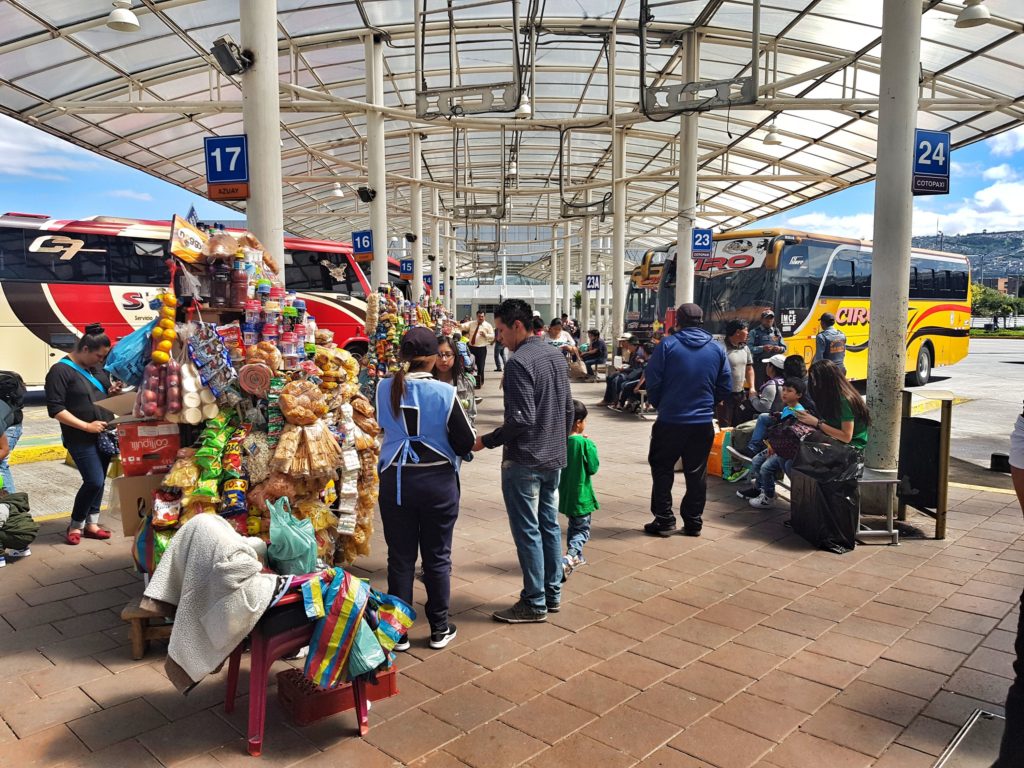
The bus terminal was as I said chaotic and confusing, people were yelling around and taxi drivers were on their hunt for gringos in the inside. It wasn’t very clear where you could buy bus tickets, but after a long quest we managed to get them somehow.
“Is the bus going to Baños directly?” – “Si, señor. Tres horas!” Well, we later found out that that was a lie. Two lies actually. The bus stopped every 15 minutes, and hordes of vendors ran through the corridor offering fruits, ice-cream, hats and other stuff. Besides, the ride took more than four hours but okay…
The bus ride didn’t spoil us with nice scenery. Not in the beginning at least. We drove along dusty roads and little unattractive villages, and everything on the way looked quite monotone. However, the closer we got to Baños the greener became the landscape.
Baños is surrounded by hills and forest, and we could tell that we were almost there. The bus ride was pretty comfortable though like everywhere else on the continent. Buses are still the cheapest and practical way to get around in South America.
I soon realized that Ecuador was very different from Colombia, the country I just visited before. Ecuador is definitely less developed than Colombia. I even had the impression that Peru, where I was in May, was more developed than Ecuador. It seemed that poverty and thus petty crime was rife here.
The internet explicitly warns you from bus-rides in Ecuador, as thieves are active during the rides. Keep your belongings on your knees is what the internet says. I haven’t read warnings like that when traveling in Peru or Colombia.
We arrived without any incident in Baños in the early afternoon. The weather was beautiful and we still had a few hours to do something. Baños is the adventure mecca in Ecuador. River rafting, bungee jumping, volcano hikes, swings… you can do all these things in the surroundings of this tiny village.
Yeah, Baños is kind of small, but we liked it right from the beginning. And it’s super touristy. That means that you will find a tour operator or a massage parlor every five meters like in Bali or Cusco.
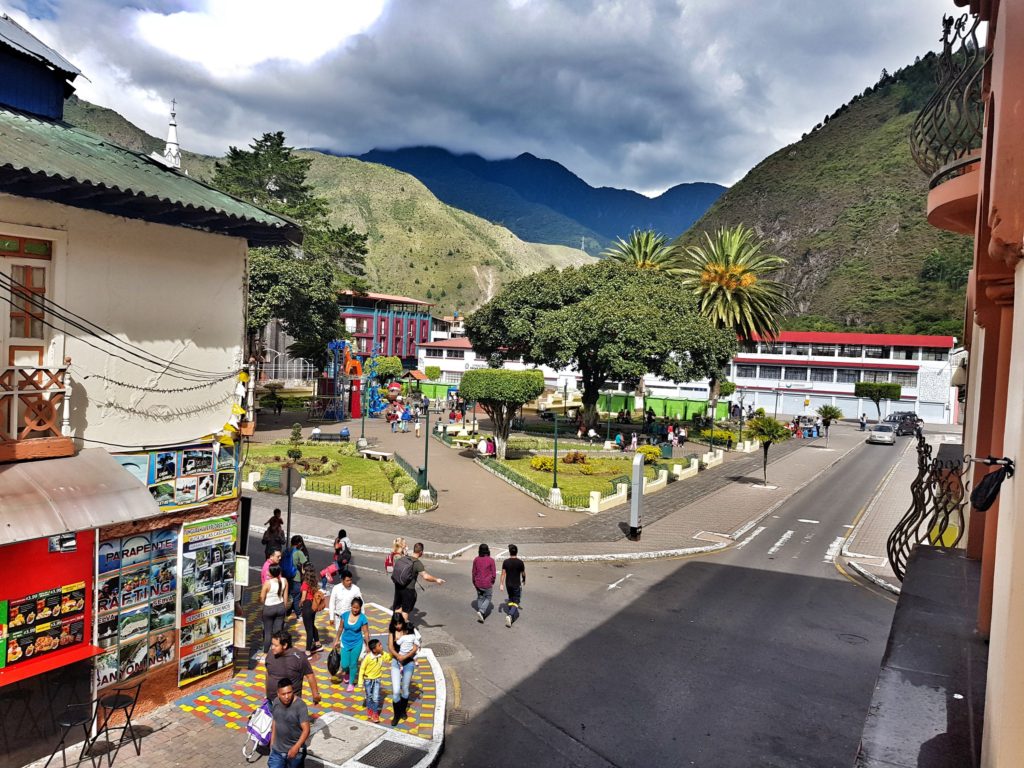
After our check-in, we met again in a burrito restaurant (we were staying in different hotels). The owner of this place was a young Ecuadorian, who was born in California. He was a cool and very helpful guy. “You have to do three things in Baños: 1) visit Casa del Arbol and try the swing. 2) go to Pailon del Diablo, a gigantic waterfall. 3) take a bath in the hot springs,” he said.
Speaking of the hot springs… Baños actually means toilet or bathroom in Spanish, and while we were wondering first why they would call a town a toilet, we assumed that the hot springs must be the reason for that. I later found out that our guess was true. The town’s full name is Baños de Auga Santa. It means baths of holy water.
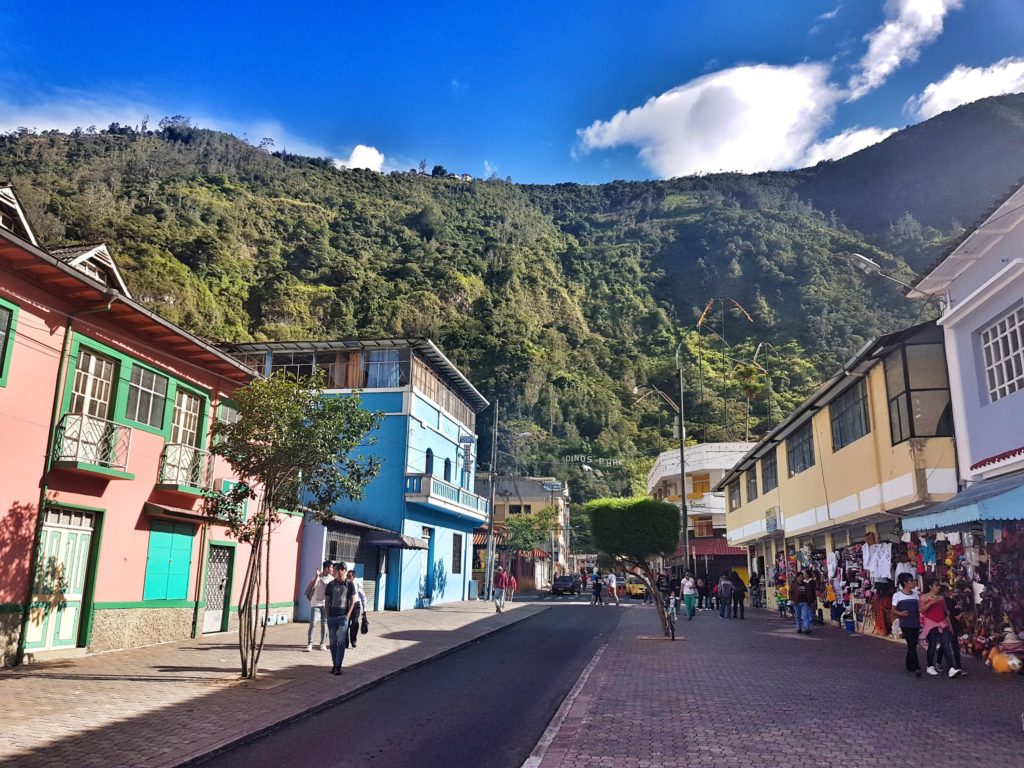
Our new friend from the burrito restaurant was so kind to organize us a tour to Casa del Arbol. He gave us three options: The cheapest one was hiking, as this option was free. The second-cheapest option was taking the public bus which costs 1 dollar. And the most expensive option (sic) was joining a tour for 5 dollars. He said that in an almost apologizing tone, and I asked myself what kind of stingy backpackers usually travel to this little town.
We opted for the tour so that we didn’t have to organize anything. The restaurant owner even helped us to save one buck (whooo!) by asking the tour operator next to his restaurant if he was going to give us a discount.
We entered a so called party bus with 15-20 other people and headed up the hills around Baños. The wind was strong and it got chilly the higher we got. “Did you notice that we are the only people not wearing a sweater?” Tobi asked. Some of the locals even wore jackets, and it didn’t take us long to realize why. It was cold.
We first stopped next to the biggest swing in South America. At least, they say it’s the biggest. The swing looked massive, but we said that we wouldn’t use a construction like that unless it’s Swiss-made. The Chinese tourists didn’t seem to care and went for it.
The second stop was Casa del Arbol. Before we entered, we saw a big poster advertising “animales exóticos” next to the image of a pony. Casa del Arbol is a treehouse, where you can swing over the edge of a mountain to get your adventurous Instagram-picture. The swing is pretty harmless in reality, but the pictures you can take there are cool.
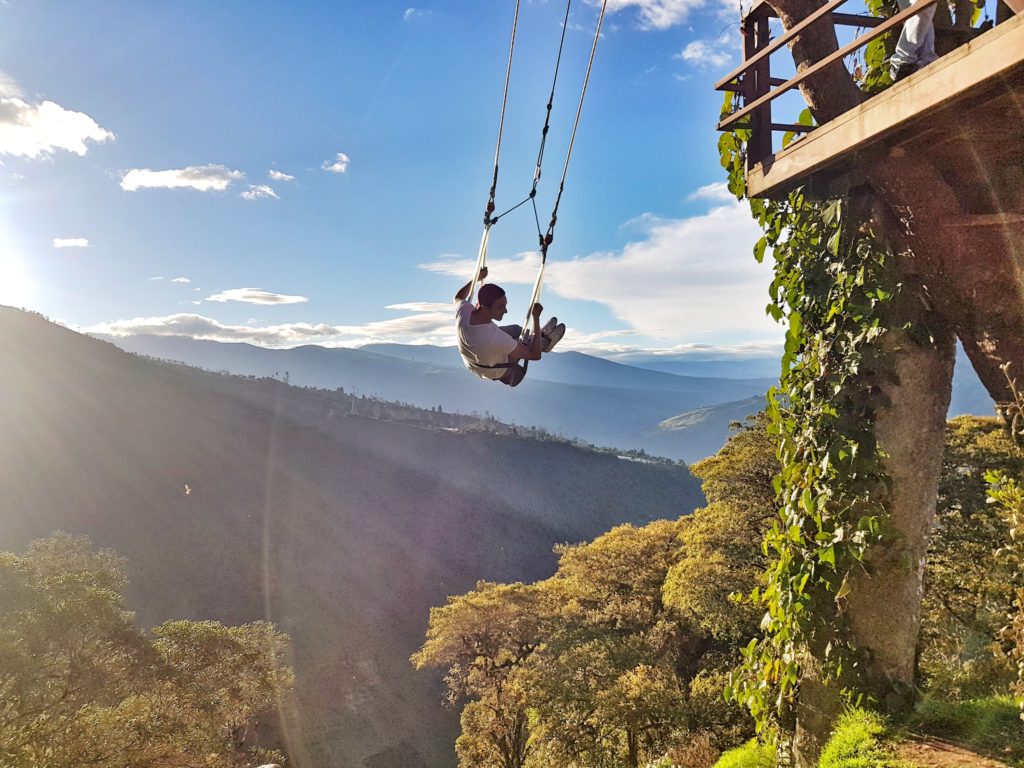
The scenery I saw up there reminded me of Switzerland. Green meadows and hills, red flowers, blue sky, and a few cows roaming around. However, I wasn’t sure if they are here considered as animales exóticos as well.
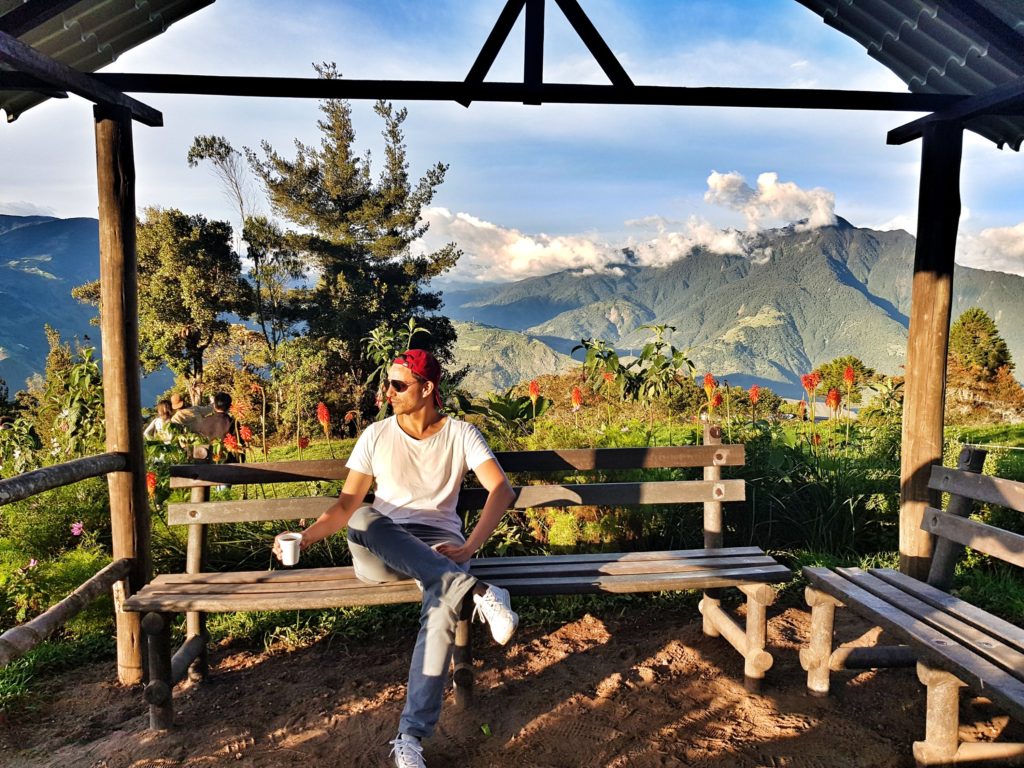
After a final stop in a sweets factory, we came back to Baños at 6.30 PM. Honestly, I really liked this little town. It reminded me a bit of Vang Vieng in Laos: a laid-back village surrounded by beautiful nature with numerous activities to do.
In contract to Quito, it was neither a problem to walk around at night. It was therefore all the more disappointing that there was no second day in Baños…
No day II in Baños but a weird encounter
My alarm clock rang at 8 in the morning. Visiting Pailon del Diablo and the hot springs was our plan for the second day. It was. Because the weather was terrible on that day. It was raining, the sky was grey and foggy. It looked like a depressing November day back home in Switzerland.
There was no point in staying longer in Baños. This is an outdoor adventure town, and I seriously didn’t take into account that the weather could be bad. We decided to give the weather a chance to change until noon and take a bus back to Quito otherwise.
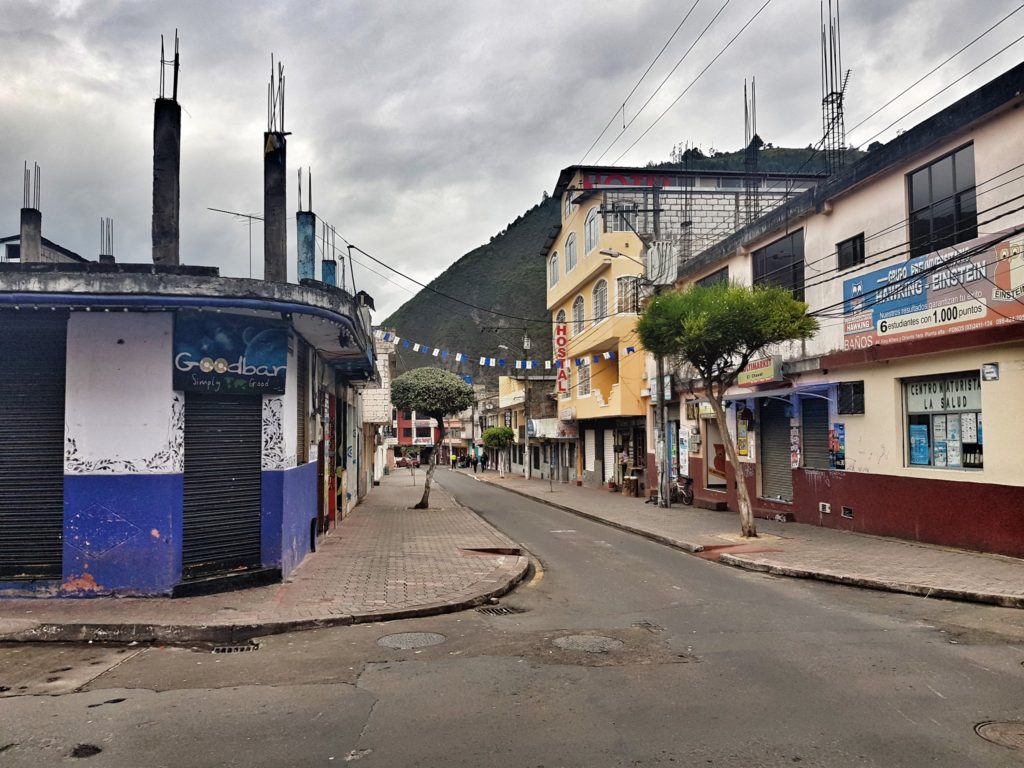
Our time in Baños didn’t end without meeting another strange character… A café next to Tobi’s and Jasmin’s hostel looked quite nice from the outside so that we decided to have a cup of coffee there. I remember that Tobi said “oh no, this place has only a 2.5 star rating on TripAdvisor” just when we entered. However, we didn’t want to have breakfast but a coffee only.
A lady, about 50-years old, welcomed us and the flag in front of the door gave us a hint that she was Danish. We were the only guests in the restaurant and ordered three cups of coffee. “Do you want to try my home-made bread? It’s delicious,” the Dane said. We declined, but she tried to convince us. “Are you sure? I know it’s a bit expensive, but it’s definitely worth the price.”
We answered that we were not hungry yet. The lady changed the subject then and started talking about Christmas, the tsunami, which just hit Indonesia and apparently Ecuador’s coast too, the Galapagos, the people in Baños and several other topics. What started as a small-talk became a long monologue. We barely answered or commented her talk anymore after a while. That didn’t stop her though. I somehow felt that something was wrong with that lady. She reminded me of Kathy Bates in the movie Misery.
The lady disappeared after ten minutes or so, but she gave her comeback a little bit later. She told us again that she couldn’t believe we wouldn’t try her delicious bread. Listening to her was exhausting. We rolled our eyes when we left this café.
On our way back to Quito, I couldn’t resist and started reading the TripAdvisor reviews about the café we just had been to. You don’t need to read more than five reviews until you realize that the Danish owner is the reason for the low ratings. People mostly complain about the rudeness of the lady and about her excessive presence.
Other people complain about the fact that the lady started to get insulting when the guests didn’t want to try her bread. It seems that she showed mercy when we were there, however, we asked ourselves how you can run a business and not understand that your behavior is a pain in the ass to many of your customers.
Priceless check-ins in Ecuador
Just a few hours later, I met the next special character after arriving back in Quito in the late afternoon. This time, we had our hotel not in old town but in La Mariscal. La Mariscal has the reputation of being the safest part for tourists in Quito, which was the reason why we chose this neighborhood. We didn’t want to be imprisoned again in our hotel at night.
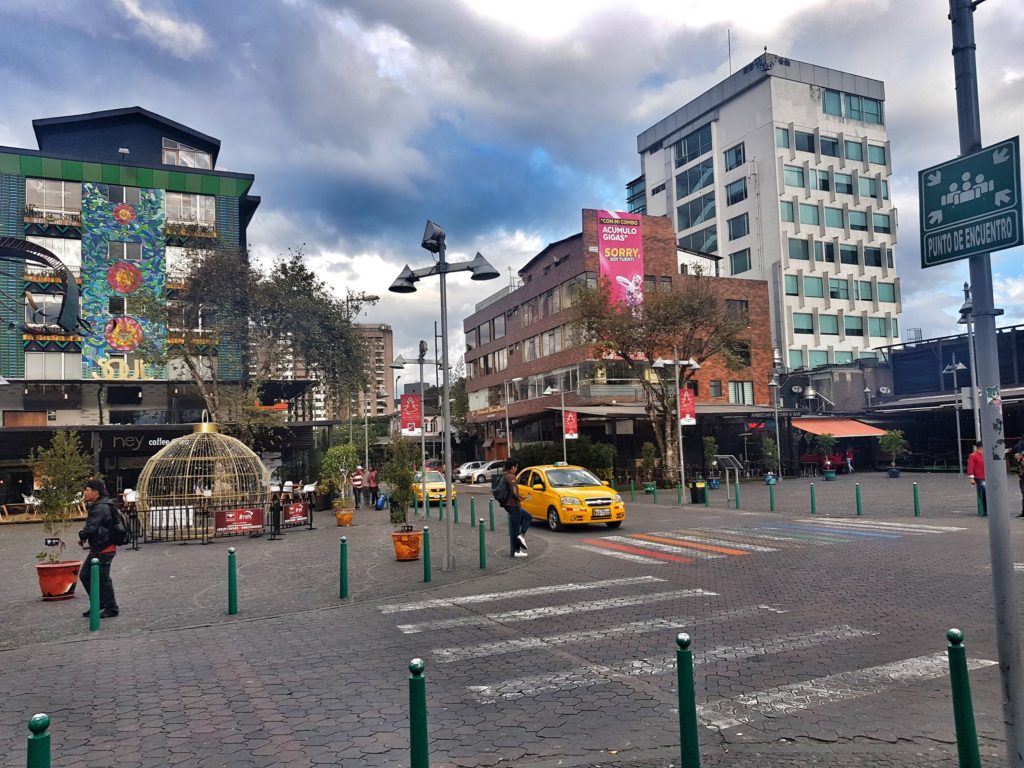
The first check-in in Quito was annoying (thanks to Latino Sheldon). The second one wasn’t better. It wasn’t a surprise that the guy at the reception didn’t speak a single word of English, and I had no idea what he was doing on his computer.
It seemed that he unsuccessfully tried to login into the hotel’s booking.com account. He entered his password over and over again, and sometimes I had the feeling that he managed to log in, as I could see my name on the screen, but then he was back again on the login-page.
The whole process took about ten minutes, while I was just standing there watching him. When he finally made it, he thought that making small-talk with me would be a nice idea. “Inglaterra?” he asked. And let me tell you something, he asked me the question if I was from England while he was holding my Swiss passport in his hands. “No, Suiza,” I answered.
Like Latino Sheldon in the first hostel, he said that he needed to add a 10% commission if I wanted to pay by credit card. He then had a quite interesting way to add 10% to the bill. The total amount was 45 dollars for two nights. He opened the calculator of his computer, typed in 45 and added 10 to it. The total amount now was 55 USD.
I tried to explain to him that this is not how you add 10% to a bill, but it seemed that he didn’t understand. I eventually typed in 45 * 1,1 and told him that this is how you calculate with percentages. Fortunately, this convinced him.
The guy, he was probably in my age, took me to my room afterwards. It was a spacious room and looked more than okay for the price I paid. The receptionist didn’t want to leave without showing me how the television worked. When I told him that I wouldn’t need a television, he looked at me as if that had been the craziest remark a hotel guest had ever made. I never waste time by watching tv in the hotel and he apparently couldn’t believe it.
Quito’s historical center
The day after, we finally had time to explore the capital of Ecuador after spending only the night there when we arrived. A taxi took us back to old town, where we had our first hostel.
It didn’t take me long to realize that Quito has one of the most beautiful old towns I have ever seen. It’s more beautiful than the historical center in Lima and also more beautiful than La Candelaria in Bogota. This part of the city is an architectural masterpiece full of churches, plazas, small alleys and colorful buildings.
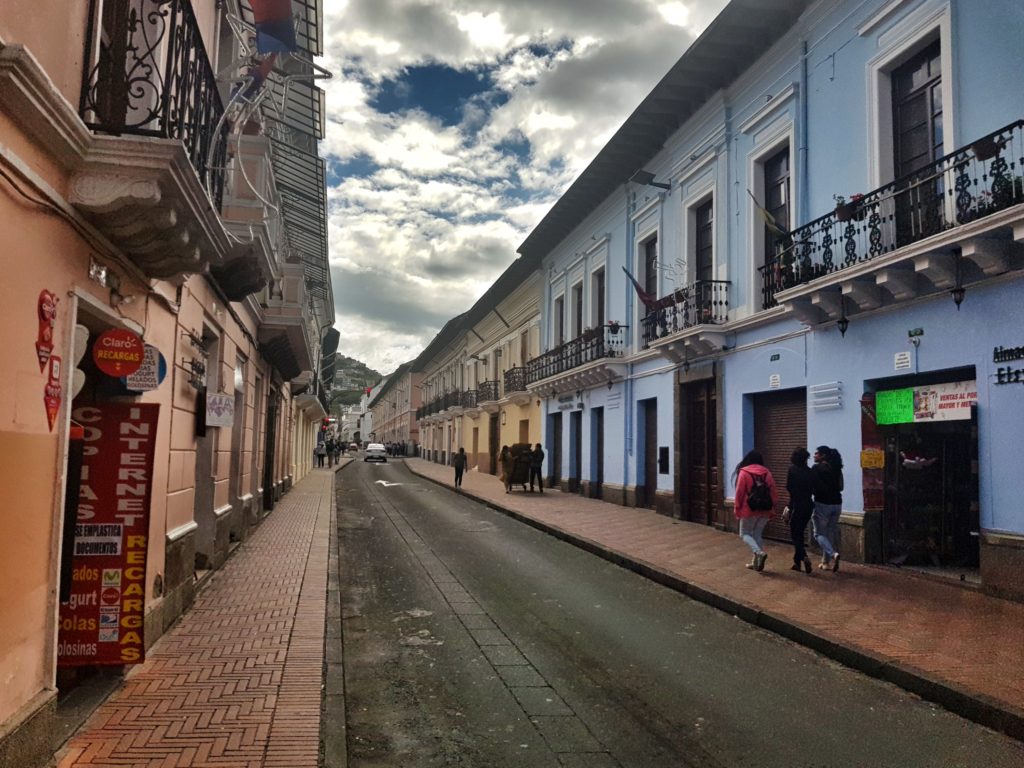
Quito’s old town has a main square of course, one of these typical colonial squares that you can see in most Spanish-speaking South American cities. Plaza de San Francisco, the main square in Quito, is quite big with an impressive church on one side.
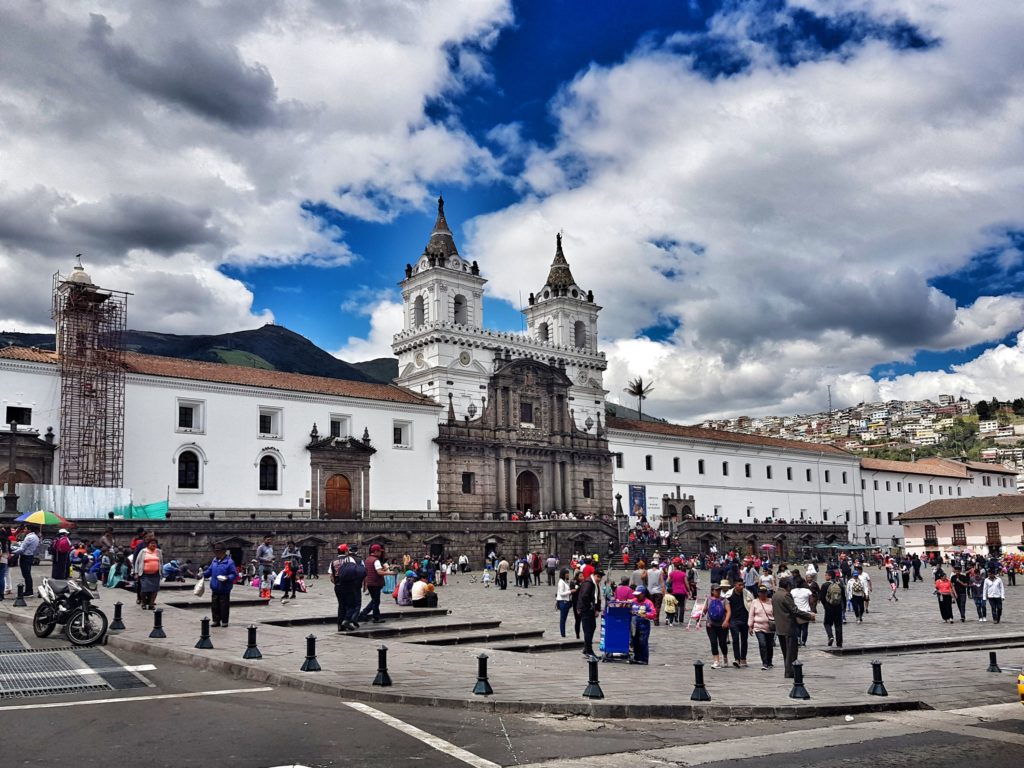
It’s also possible to enter the church in order to see the beautiful garden, one of the many picturesque places in old town.
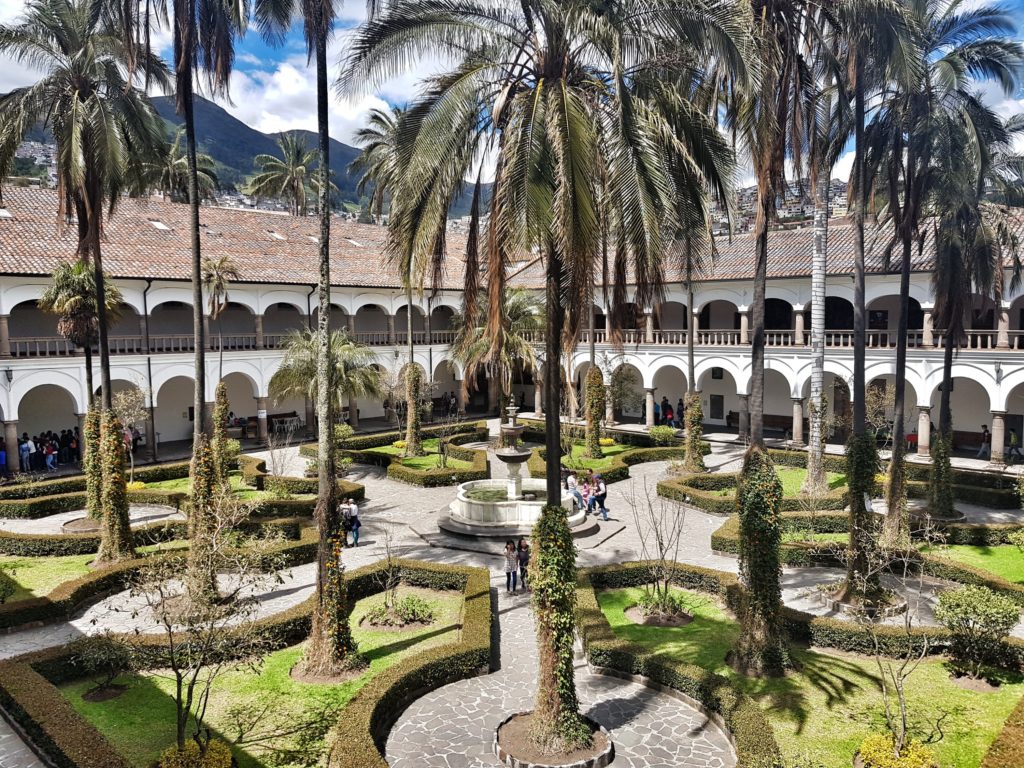
The streets in old town were crowded and full of stalls with snacks and drinks. We also saw a lot of (mostly young) people selling exactly one item on the streets, for example glue or batteries. I have no idea whether they have stolen it or where this item comes from.
Besides, I asked myself how successful that business would be. I mean, how realistic is it that someone strolls through Quito and thinks ‘oh, the product I could use the most now is super-glue.’? It must work somehow, they wouldn’t sell these things otherwise.
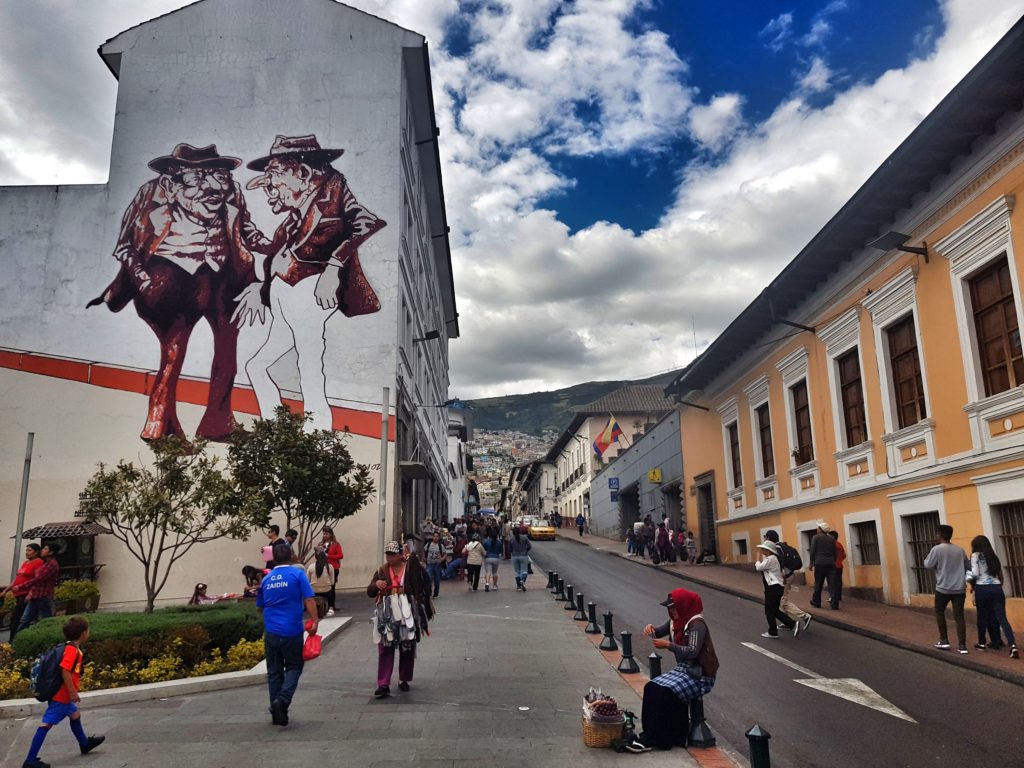
Another impressive sight is the Basilica del Voto Nacional, the largest cathedral in Ecuador and also the largest neo-Gothic cathedral in the Western Hemisphere. Unfortunately, the church was closed when we arrived so that we couldn’t climb the stairs and take a picture from the top. Nevertheless, standing in front of this massive construction was also worth it.
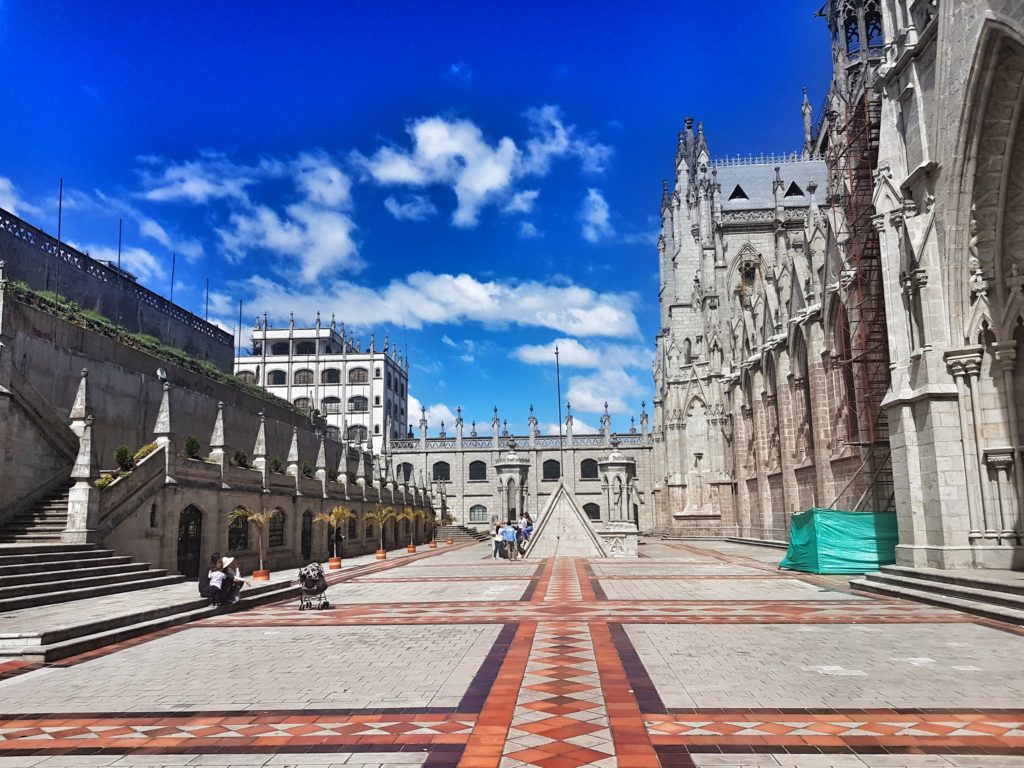
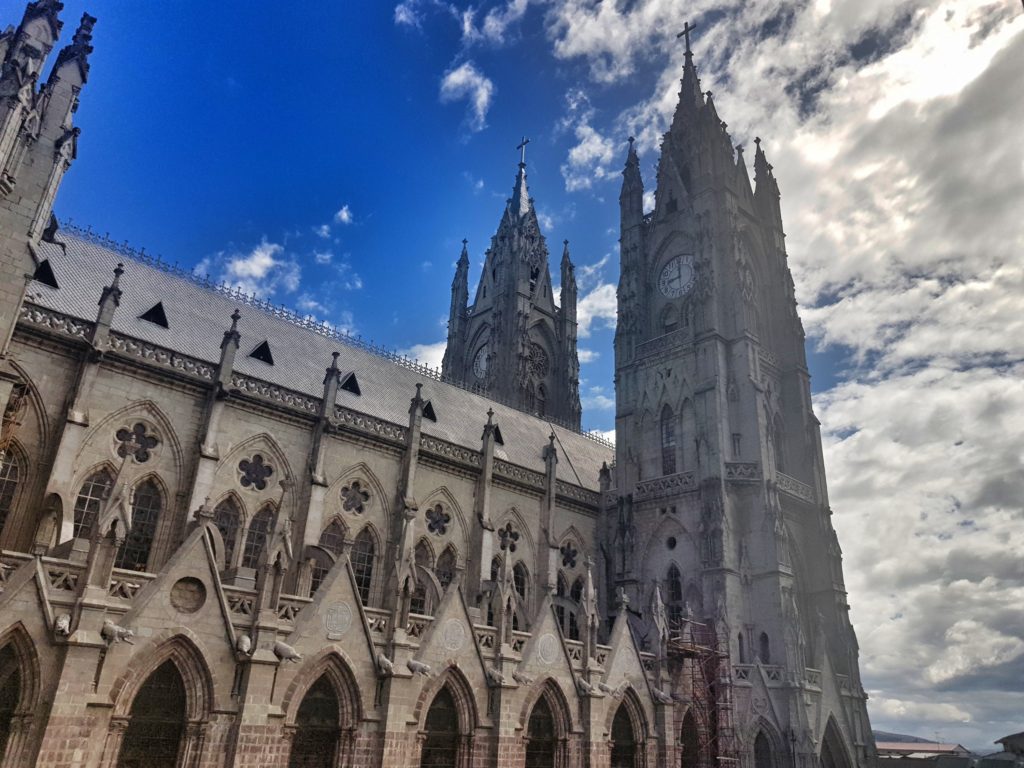
The last attraction we wanted to see in old town was Calle La Ronda. They say it’s Quito’s oldest street, but it’s rather a narrow, cobblestoned alley with artisan shops and a few cafés. Not the attraction of the century in my opinion, but if you’re already in Quito…
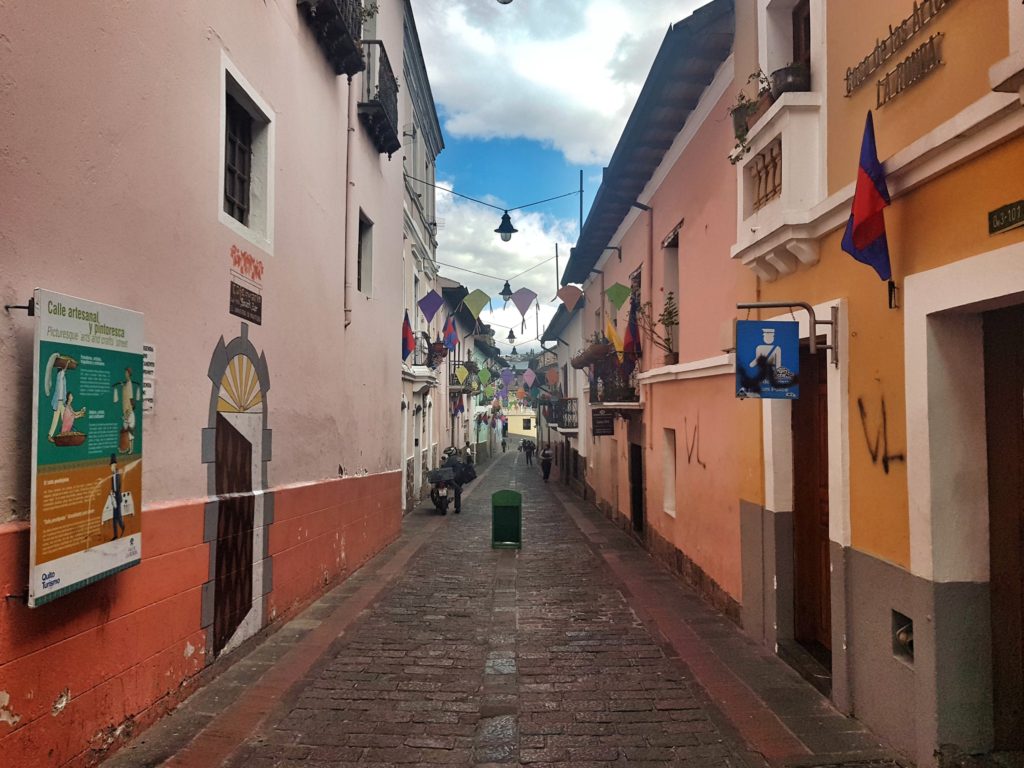
We finished our old town tour in a café near Independence Square, where we enjoyed snacks and drinks that were very cheap. Speaking of prices, I find it hard to say whether Ecuador is a cheap country or not compared to its neighbors. Some things are ridiculously cheap in Ecuador, while other things are rather expensive.
For example, taxis and Uber cost more than double the price that you would pay in Colombia. And you always pay at least 10 dollars for a ride in Quito. A local SIM card with 2GB data will set you back 20-30 dollars in Ecuador but only 6-7 dollars in Colombia. A box of cigarettes is almost as expensive as in Western Europe (6 dollars in mainland Ecuador, $7.50 on the Galapagos), while you only pay 2-3 dollars in the neighboring country in the north.
On the other hand, you only pay 4 dollars for a four-hour bus ride in Ecuador, and hotel prices seem to be cheaper than in other South American countries. Food and drinks are also cheap. However, I believe that travelers generally pay less in Colombia or in Peru than in Ecuador. And I’m only speaking about mainland Ecuador, don’t get me started with the Galapagos…
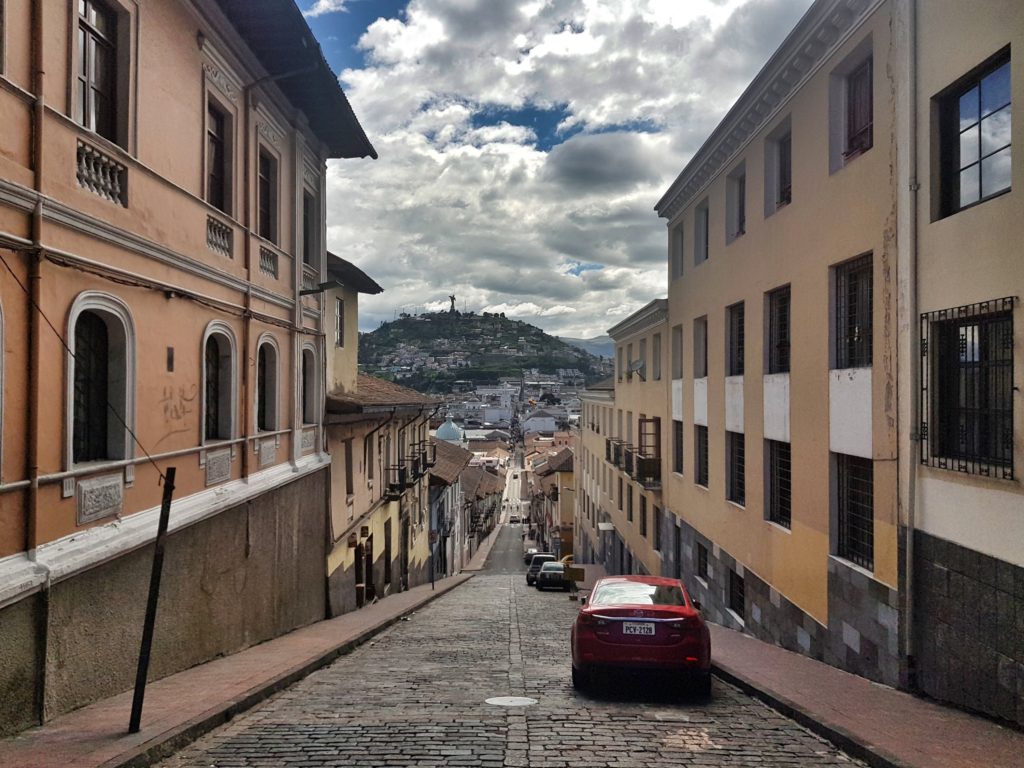
Our time in Quito came to an end after that day. To be honest, I really enjoyed the historical center but I didn’t become a fan of Quito. Among all cities I have seen in Latin America, the capital of Ecuador turned out to be the one I liked the least. Infrastructure is too weak, and the city too big and too dangerous after dark. Even in La Mariscal, I was happy that I don’t look like a typical gringo, as soon as I was a few streets away from Plaza Foch, the main square of that neighborhood.
Quito combines the beauty and the ugliness like no other city in South America. You will see nice colorful buildings surrounded by green hills and beautiful clouds (due to the high elevation), but also old, run-down concrete houses that reminded me of destitute cities in the Middle East. Nevertheless, spending one full day in Quito was more than okay, as we witnessed the beautiful historical center, but we were ready to leave.
Last stop: Galapagos Islands
The Galapagos Islands were the big finale of my South America trip through Colombia and Ecuador. My final destination in Ecuador is not only a dream destination to many people, even I wanted to visit the Galapagos for a long time. I am usually not a big fan of island destinations, but the Galapagos are simply a unique place in the world and all the people who have been there are raving about it.
The Galapagos have their own check-in area at Quito airport, where you have to pay the first $20 tax and declare that you don’t have any organic material in your luggage. The Galapagos are probably the most protected place in the world a tourist can visit. Bringing seeds, plants, fruit or animals can heavily harm the environment on these islands, and it’s considered a severe crime. Therefore, all pieces of luggage are separately screened before you proceed to the regular security check.
What happened in the plane was the bigger spectacle though. Shortly before landing, flight attendants sprayed the overhead bins with an insecticide to reduce the chance of introducing insects. More of this substance (or was it a spray for something else?) came out of the ceiling after the landing.
The same thing happened on the flight back, where I captured a video:
You can stay on four of the 18 main Galapagos islands, and I decided to spend three nights on Santa Cruz and two nights on Isla Isabela. Tobi and Jasmin added four additional nights on San Cristobal Island to their itinerary.
We arrived at Baltra airport next to Santa Cruz Island at noon. Finally. I was quite euphoric to be honest. Fortunately, I read some blog articles saying that you shouldn’t expect too much from the scenery you see during the transfer from the airport to the center. And these articles were telling the truth. The landscapes you see on your way to Puerto Ayora, the city center of Santa Cruz, are everything but beautiful.
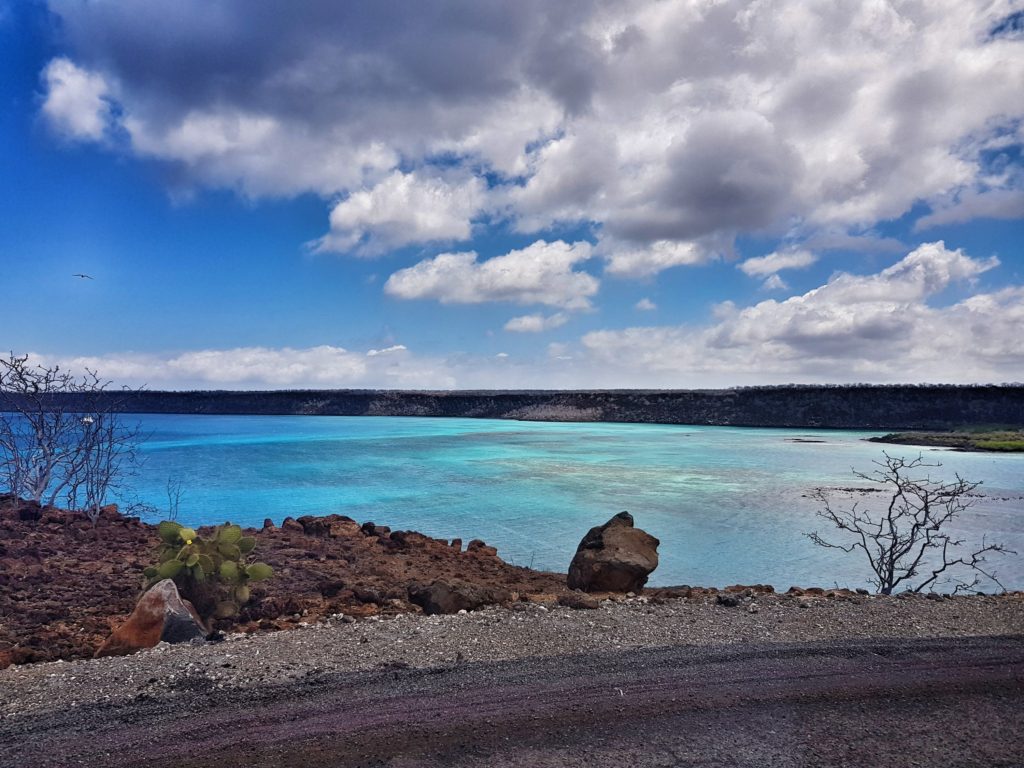
I worried about other things though. The days between Christmas and New Year’s Eve are peak season, and I didn’t book anything in advance. What concerned me were some articles I found online claiming that it’s almost impossible to find tours on short notice during peak season. Some articles even stated that you have to book nine months ahead if you want to do day-trips.
Honestly, I was quite nervous because of that. The Galapagos should be a once in a lifetime experience for me, and I wanted to see as much as possible therefore. The catch is that you cannot see much on your own, as only 3% of the National Park are accessible without a tour guide. I was afraid that I would miss the best of the islands because I was too late. Another problem is that most of the day-trips set you back between 120 and 250 dollars. So even if I could find a tour on short notice, it wouldn’t be a bargain, I thought.
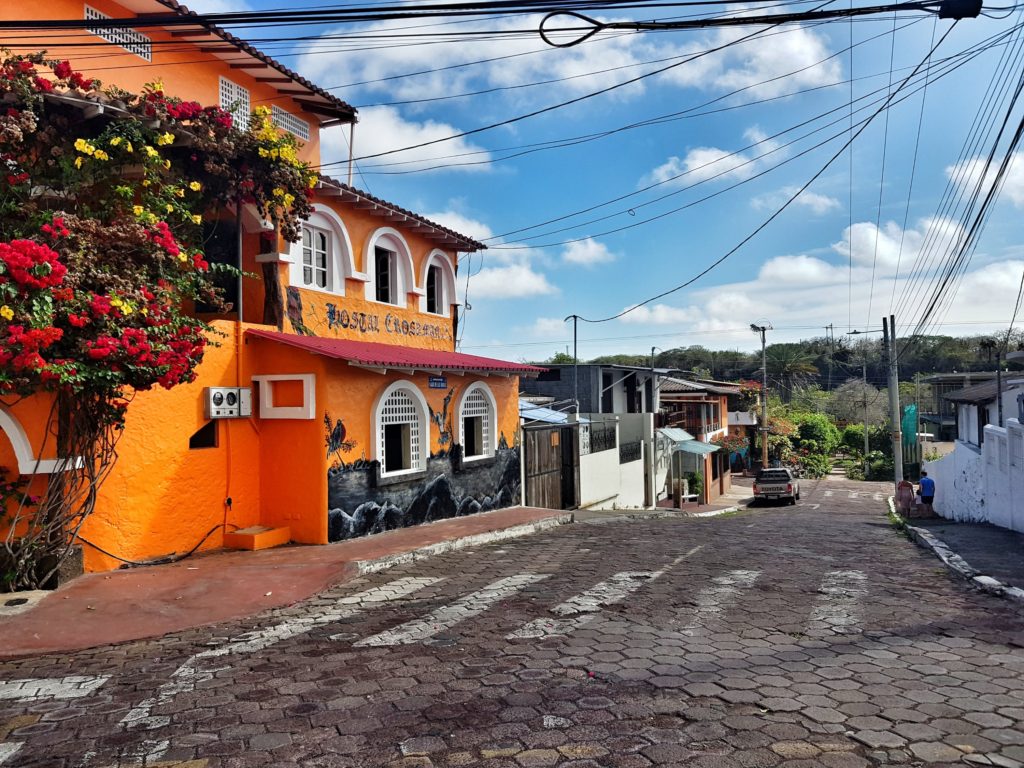
Tobi, Jasmin and I arrived at the hostel, which the two later called “the worst on their entire world trip”. They were right, our room was tiny, hot and with a little window only. However, we only paid $18 dollars per person and I couldn’t complain therefore. We didn’t want to loose much time after the check-in though. The two had to book a diving trip, while I needed find available tours…
It turned out that my worries were groundless, because all the tours I wanted were still available. My original plan was to visit Bartolomé Island and Santa Fé while on Santa Cruz and Los Tuneles when on Isla Isabela. Tour agencies are everywhere in Puerta Ayora, and I checked out at least five of them in order to get the best prices. The prices were more or less the same in each shop. In the end, I booked the Bartolomé tour for $180 and a snorkeling tour, on which I would visit Isla Pínzon and Isla Daphne, for another $140.
So, enough with the logistics. We still had a few hours before sunset, and we wanted to see something. The Charles Darwin Research Center seems to be the common afternoon activity for people who have just arrived in the morning or at noon. Charles Darwin spent five weeks on the Galapagos in the 19th century. Therefore, there is no other name linked more to the islands than Darwin’s. The Research Center is only a 10-minute walk from the center, and you soon see the first animals.
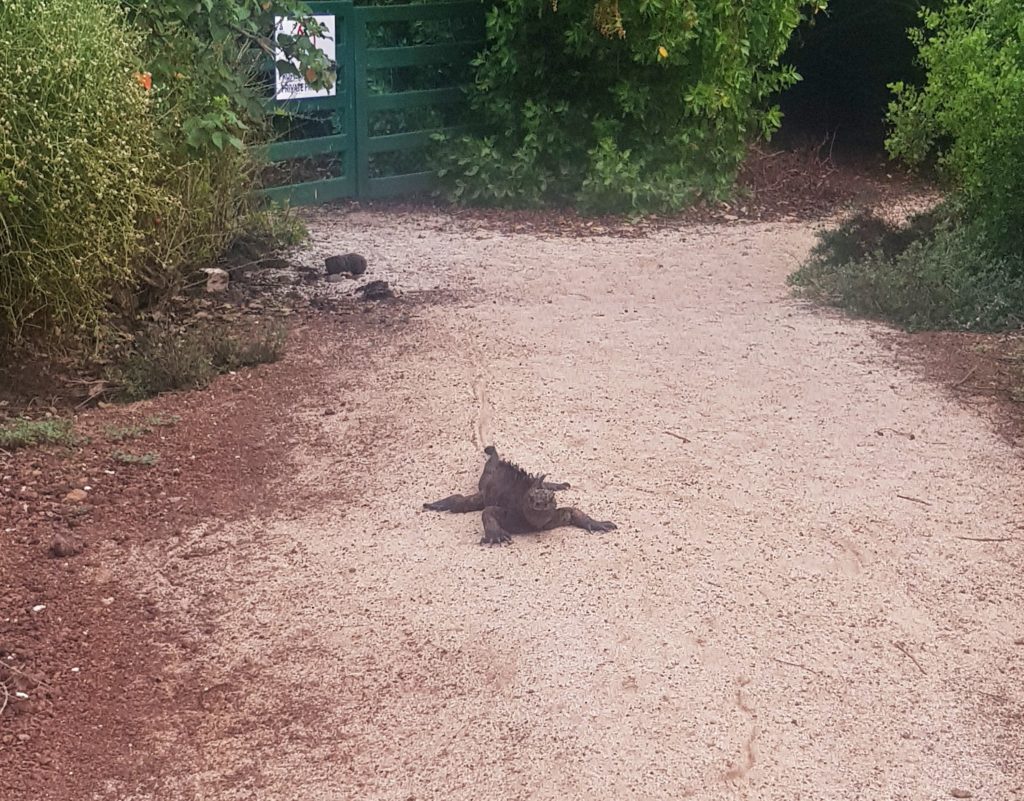
These scary-looking little dragons are iguanas, and they are the animals one sees the most on the islands. They are literally everywhere. It can be a little intimidating if they lie on the side of a one meter wide path and you have to pass by, but these creatures are harmless plant eaters.
The Galapagos are not famous for their iguanas though but for their giant turtles. During your visit to the Darwin Research Center, you will see plenty of them. The star among the tortoises was Lonesome George before he died in 2012. He was born in 1910 and became 102 years old. However, the oldest (known) tortoise would laugh about this youthful age. Jonathan, a Seychelles giant tortoise, was born in 1832 and lives in St. Helena. It’s the oldest known living terrestrial animal in the world.
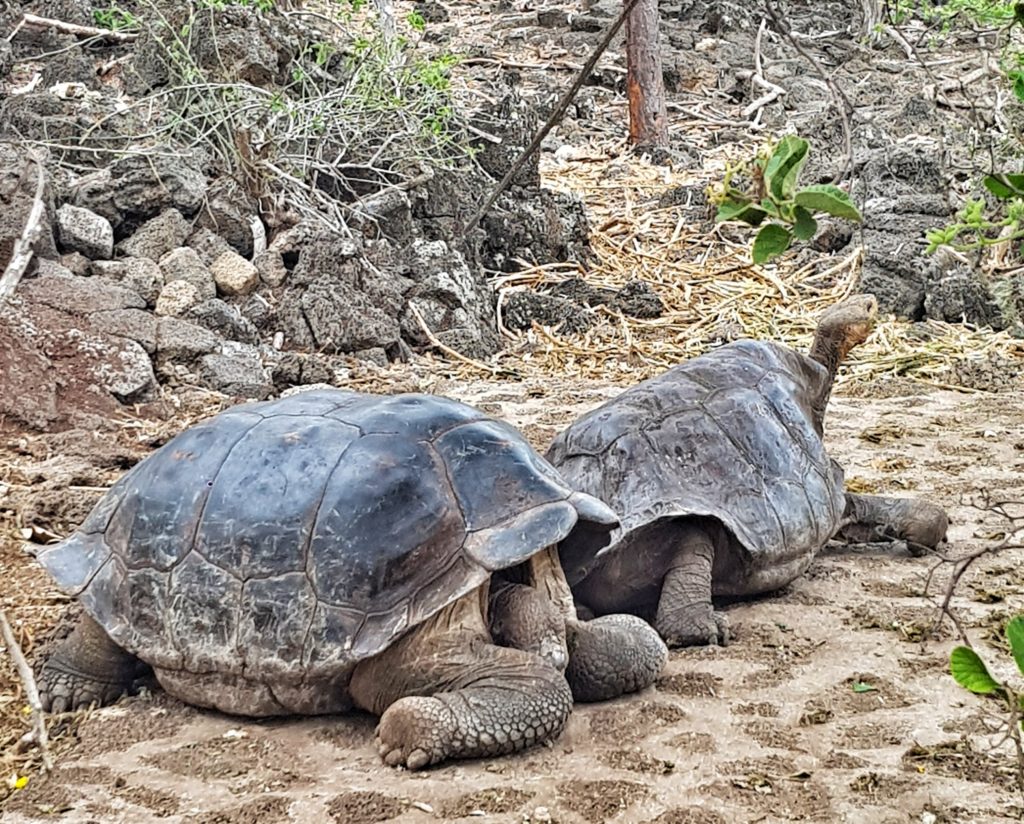
The trip to the Darwin Research Center was actually pretty cool. Although it’s more or less a tortoise zoo, we also learned a few thing about the Galapagos. For example, I now know that snails and blackberries are a huge threat to the local agriculture.
Bartolomé Island
The alarm clock woke me up at 5.30 AM. The Bartolomé tour starts early, but hey, it was nothing compared to all these trips in Peru, where I had to wake up at 4 AM sometimes. Getting woken up before 6 AM should be against the Geneva Convention, but what can do you when you want to visit the most spectacular places on earth…
A minibus drove us back to the ferry terminal near the airport, where we took a boat to Bartolomé Island. I never got seasick in my life before, but the sea became so rough after one hour that I had to focus in order not to puke. A perfect distraction were dolphins. They suddenly appeared on the side of our boat and started swimming next to us. The dolphins wanted to interact with us and I could take one of the coolest videos ever. Seriously, watching these dolphins jumping out of the water and trying to get our attention was one of the most magical moments I had ever witnessed.
Bartolomé is a volcano island and one of the most visited spots, because you can take the best picture of the Galapagos from top of the island. The Bartolomé tour is also one of the few tours that is not just a diving or snorkeling tour. You go snorkeling for one hour but that’s it.
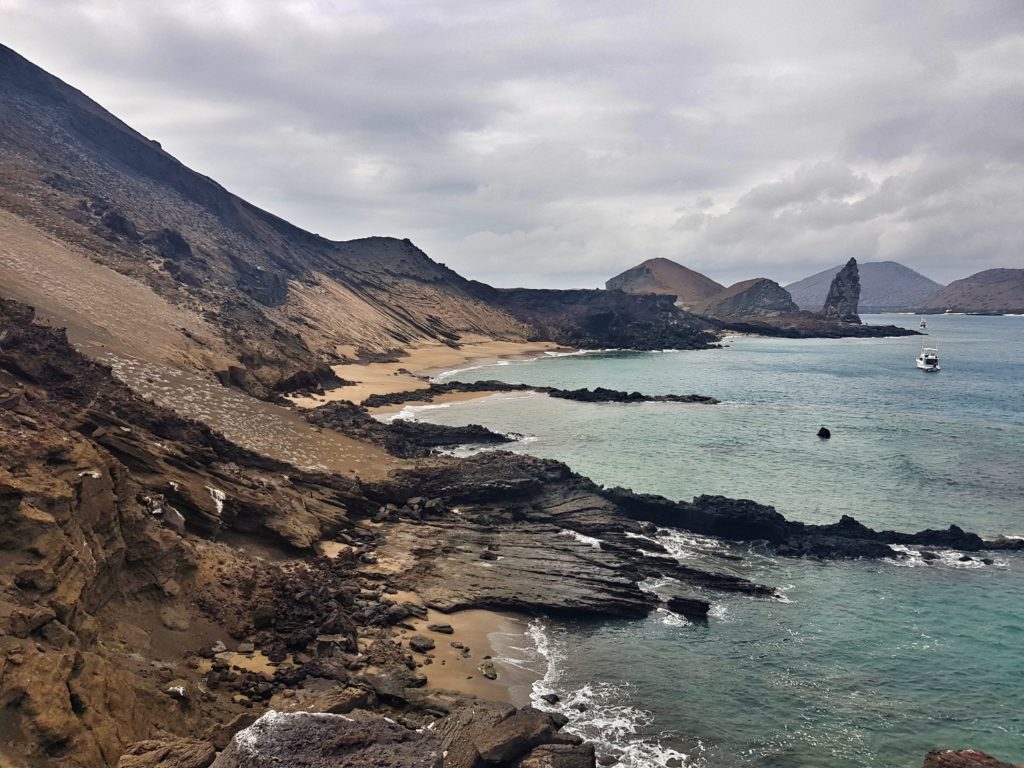
Hiking to the top wasn’t very challenging, as we did a break every five minutes. Our tour guide used the breaks to tell us something about this island. For example, the first plant that grew on this island was a cactus. Cacti have very aggressive roots that can turn stone into mud. The mud makes the surface of the island fertile and other plants can grow. So, how can plants “arrive” on a island? Either by the sea or when a bird drops a seed.
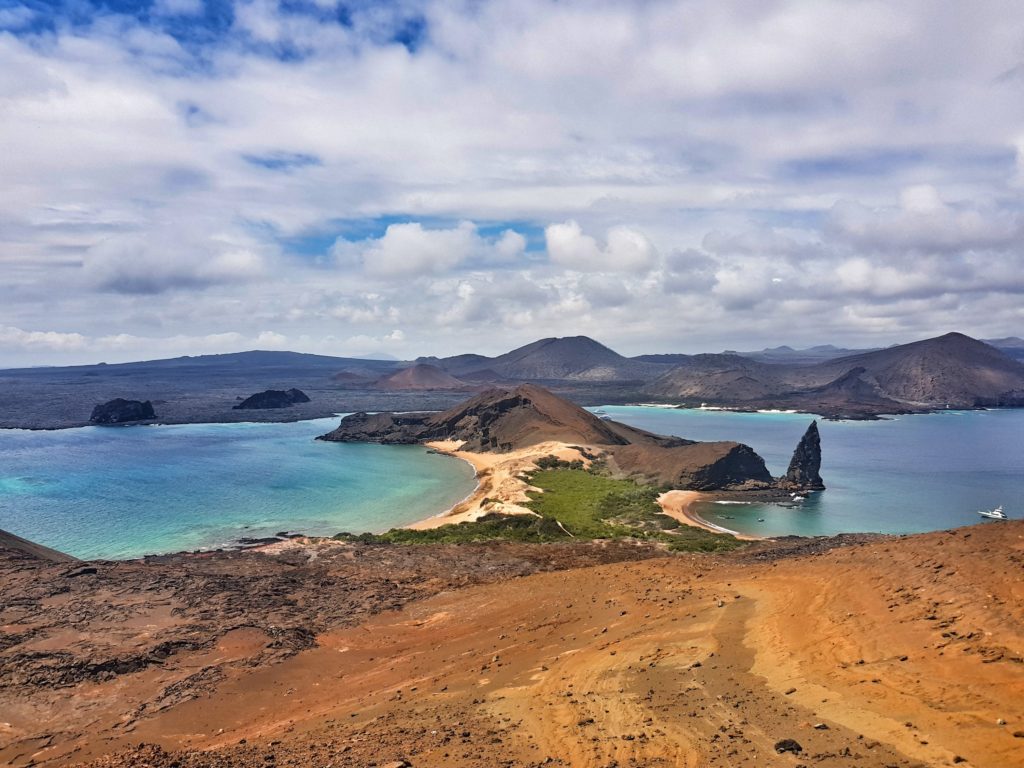
We reached the top approximately 45 minutes after the start. The sun was burning. The Galapagos lie directly on the equator (Ecuador is named after the equator by the way) and the sun becomes a real threat therefore. One of us fell victim to the sun the day after, but I will come back to that later.
Snorkeling was the next and final part of the tour, and once again I found out that this is not an activity I enjoy. I mean, it’s nice for five minutes but I get bored afterwards. I did many snorkeling tours in different countries and I didn’t enjoy it a single time. This time, I saw a giant tortoise and many fishes, but once again I wanted to get out of the freezing water after a few minutes. In the same time, I was thinking about the snorkeling tour I booked for the next day. How could I? That was even a full day snorkeling tour.
To say that our boat ride back to Santa Cruz was unpleasant would be the understatement of the year. It was a nightmare. The sea was so rough that I got seasick very soon. The French guy on our boat felt even worse, because he was throwing up for the next 45 minutes. I have to admit that I was also fighting against it. Fortunately, I didn’t have to. Standing on deck and focusing on the horizon was a huge help thereby.
The tour came to an end two hours later. It was a cool trip, however, also a very expensive one with two painful boat rides.
Tortuga Bay & Las Grietas
The first thing I did after coming back was cancelling my other snorkeling tour. I got my money back, part of it at least, and this turned out to be the right decision. I still felt sick from the boat-trip, and the last thing I wanted was to be on a boat again in the next 24 hours.
There are a few things you can do for free on Santa Cruz Island, and we opted for Tortuga Bay and Las Grietas as our program on the third day. Tortuga Bay is about a 25-minute walk from Puerto Ayura, and one of the most beautiful places I have seen in Ecuador. Visitors have to register at the entrance when arriving, a narrow path leads you to the gigantic beach then.
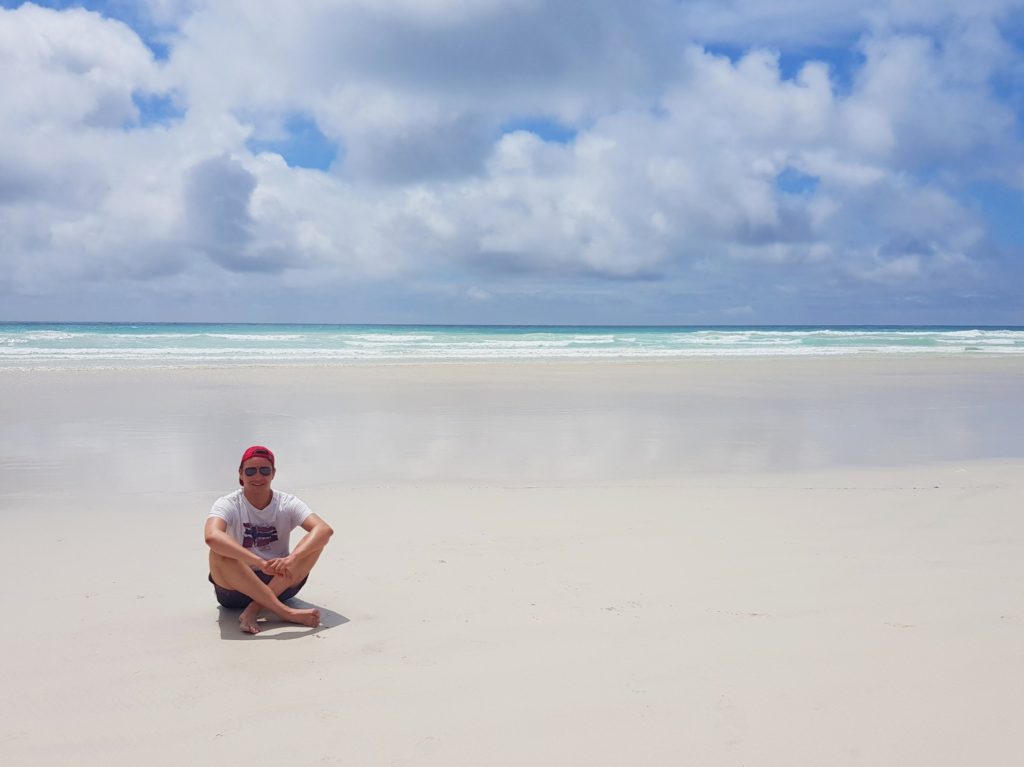
Of course, we weren’t the only creatures on the beach. We saw plenty of iguanas on the sand and in the water as well.
You shouldn’t swim there, they say, as currents are too strong. However, there is another beach right next to it, although not as beautiful as the first one. The water is much calmer there and safer to swim therefore.
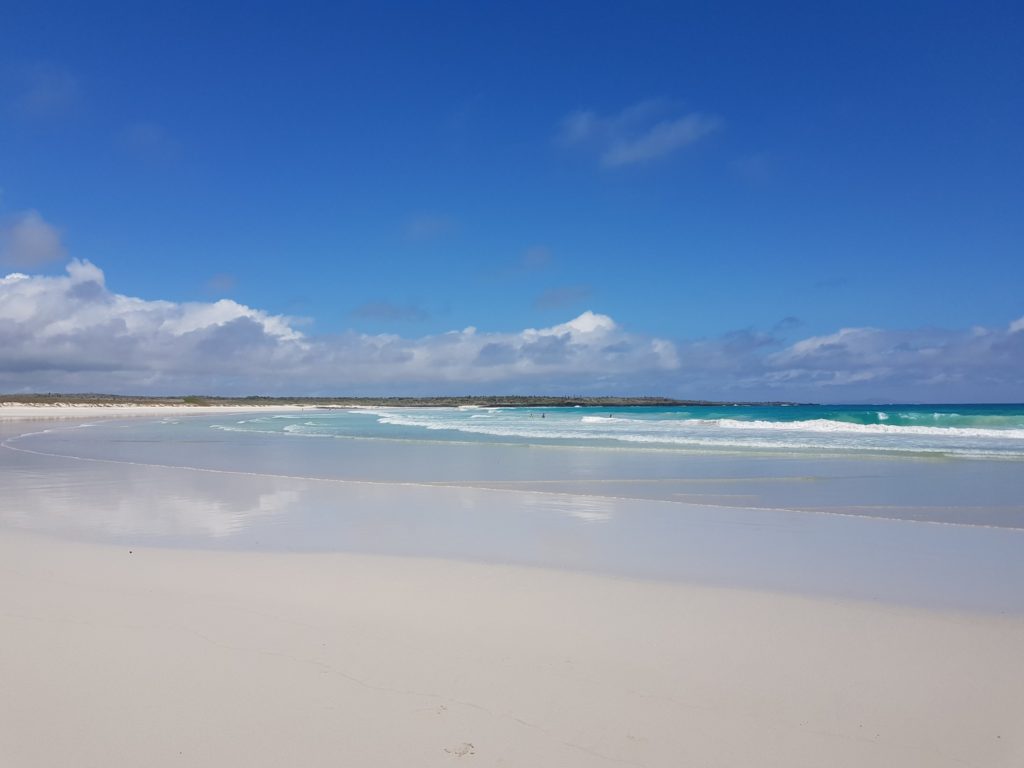
I was wondering why all the Ecuadorians were sitting under trees. We had only 28°C and the sun didn’t seem to be too strong. We found out the answer the most brutal way… Although we put sun-cream on our bodies, the sun was simply too strong. Once again, I was happy that I don’t have the skin of a typical gringo, as my sunburn wasn’t worth mentioning. The other two didn’t have as much luck as me, especially Tobi got the sunburn of the year.
Another attraction we visited was Las Grietas, a lagoon that you can reach by water-taxi. It’s an interesting walk to the lagoon, and it showed us how diverse the island is.
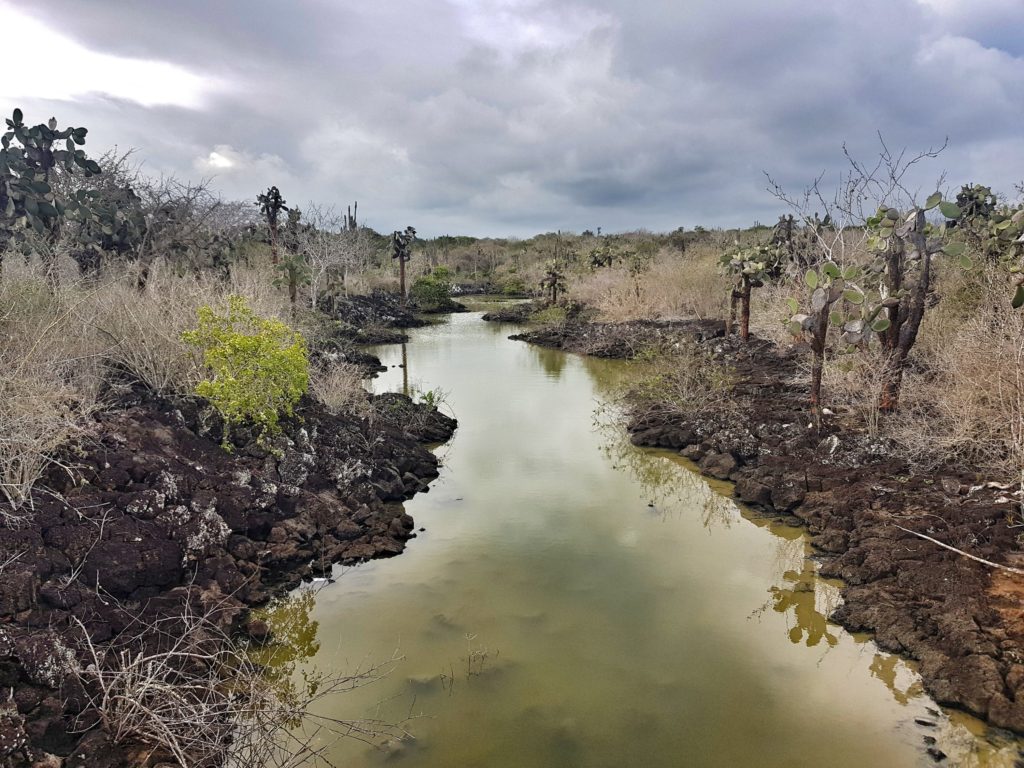
The lagoon was a bit crowded but the cool water between the rocks was a good refreshment after getting grilled by the sun. It was our last activity on Santa Cruz Island before heading to Isla Isabela.
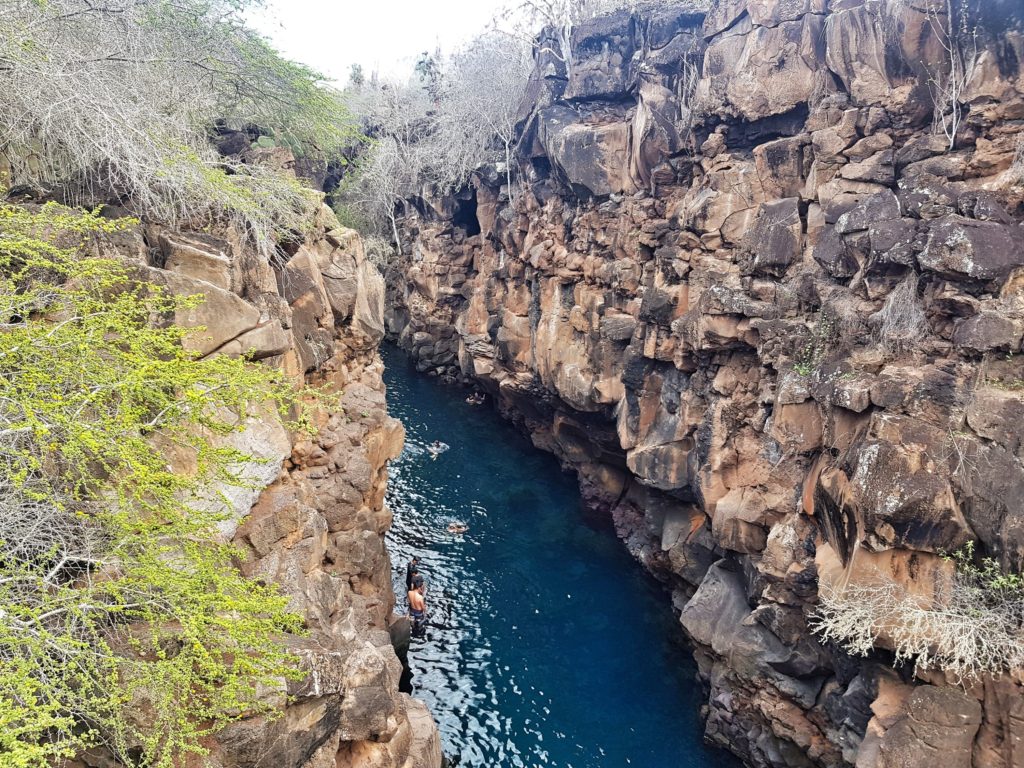
Isabela, I have to break up with you
I’m telling you, the boat ride from Santa Cruz was another nightmare. Not for me, I felt good, but for the guy sitting three rows behind us. He threw up numerous times and looked like a zombie when we arrived after two hours. Boat rides between the islands aren’t fun here.
Anyway, we arrived on Isla Isabela, our next (and my last) stop on the Galapagos. To be honest, the first three days on the Galapagos were cool. The last two weren’t. Isla Isabela disappointed me right from the beginning. Although Santa Cruz Island wasn’t a beautiful paradise island, it had its charm and a lively town center at least. Isla Isabela was a different story. The island looked like a dump and was a ghost town.
So, why did we choose Isla Isabela instead of San Cristobal? It was a coin-flip to be honest. The internet says that both islands are different but you can do great things on both. In hindsight, I wish that I had chosen San Cristobal as the second island to visit. Tobi and Jasmin went to that island afterwards and they said that it was way better than Isla Isabela.
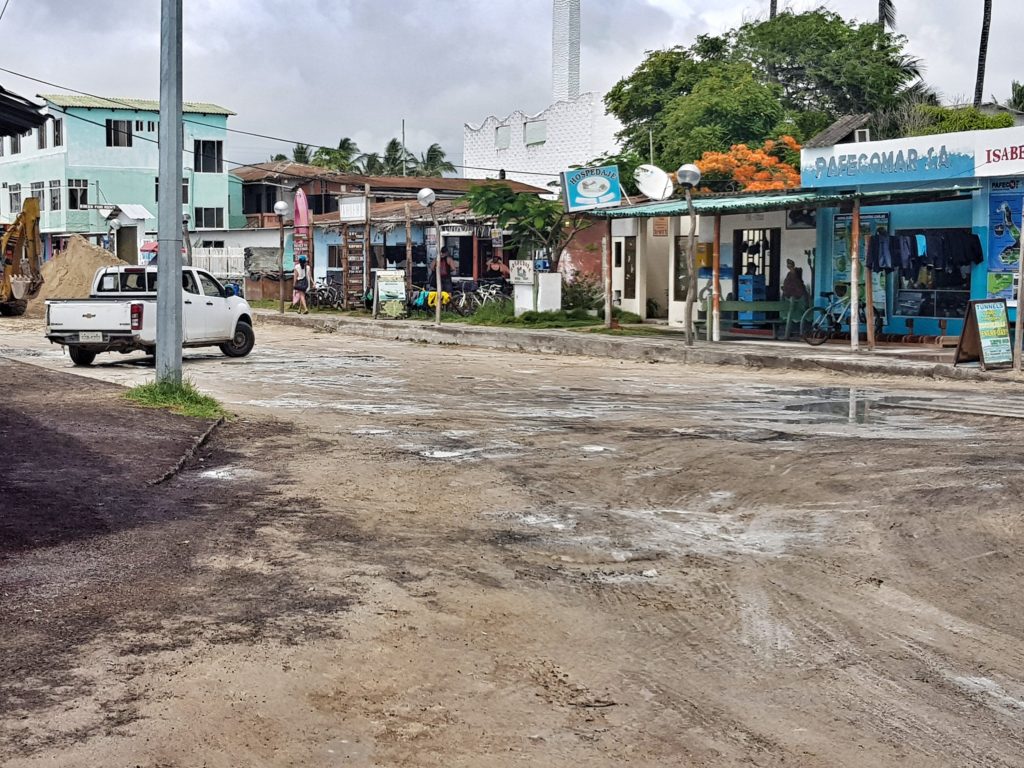
Isla Isabela is by far the largest of the Galapagos Islands, and also the largest one in Ecuador. However, Puerto Villamil, the town on the island, is way smaller than Puerto Ayora in Santa Cruz. Activities on Isabela are limited unless you want to leave the island for a snorkeling or diving tour. Los Tuneles is the most famous snorkeling tour, but it was pretty hard to find a tour that wasn’t fully booked.
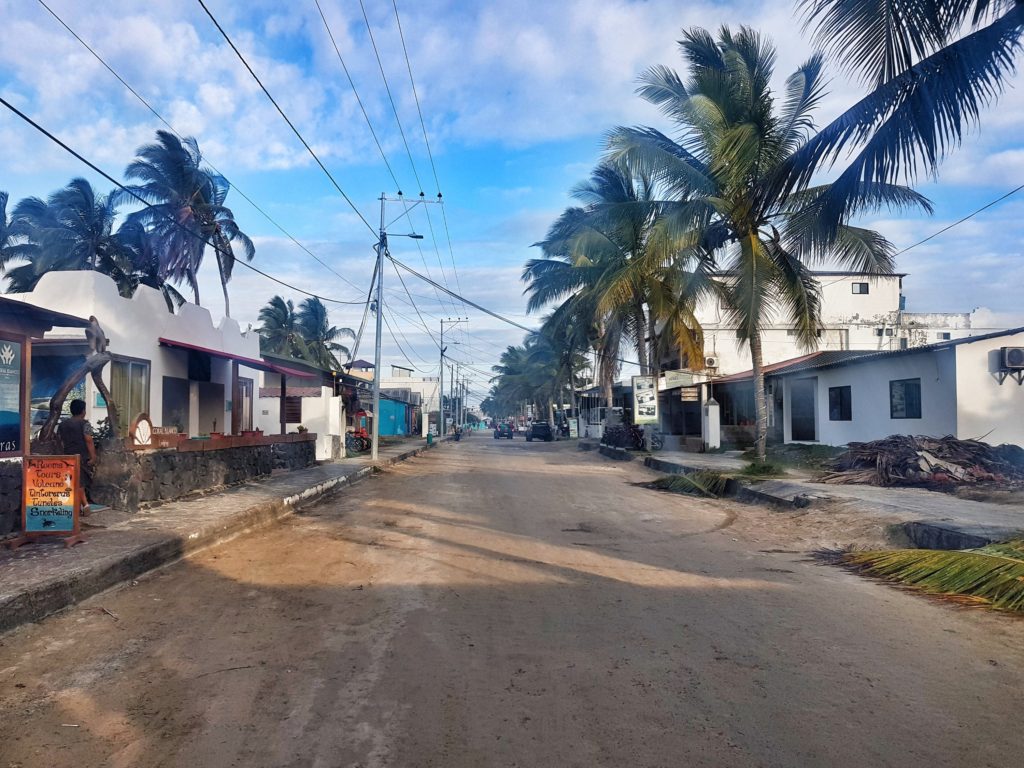
Another problem was Tobi’s sunburn. His feet were as swollen as I have never seen it before. That meant that he would stay away from the sun the next days. I explored Puerto Villamil by myself therefore, but there wasn’t much to see. The beach didn’t look nice, and I neither wanted to spend money on the volcano hiking tour. The pictures of the volcano I found online didn’t look very intriguing.
As a consequence, I didn’t join a tour anymore. The available tours didn’t fascinate me. Perhaps, I was also tired after 2.5 weeks of traveling, but I mean, why should I spend money on something I don’t really want to do? My last two days on the Galapagos were my least active days during the trip therefore. While Tobi and Jasmin stayed in the hotel room during day-time, I checked out the beach again and Pearl Shell, a place where you can go snorkeling with sea-lions.
Although my last two days on Isla Isabela were unspectacular, I captured another cool video. The sea-lions were the only animals that haven’t bored me after seeing them more than three times. These cute animals were mainly located near the port, and it seems that they have a preference for benches.
Another big minus of Isla Isabela was the food. There are between 15-20 restaurants on the island and most of them have an average rating on TripAdvisor. We had good food in a restaurant though. Unfortunately, it was the restaurant we visited on our last night. In the end, the last two days in Ecuador were disappointing. I didn’t like Isla Isabela at all and I was glad that I could leave.
So, are the Galapagos worth the trip? It’s hard to say. I wrote a separate article about that topic with detailed information about the costs as well. To summarize, I think the most important factor for travelers, who visit the Galapagos, is managing their own expectations. Are you a biologist, a diver or are you interested in a unique flora and fauna? And are you willing to pay a lot for that? Yes, then you will definitely love these islands. People not into diving or snorkeling might be disappointed, because almost all tours include these activities.
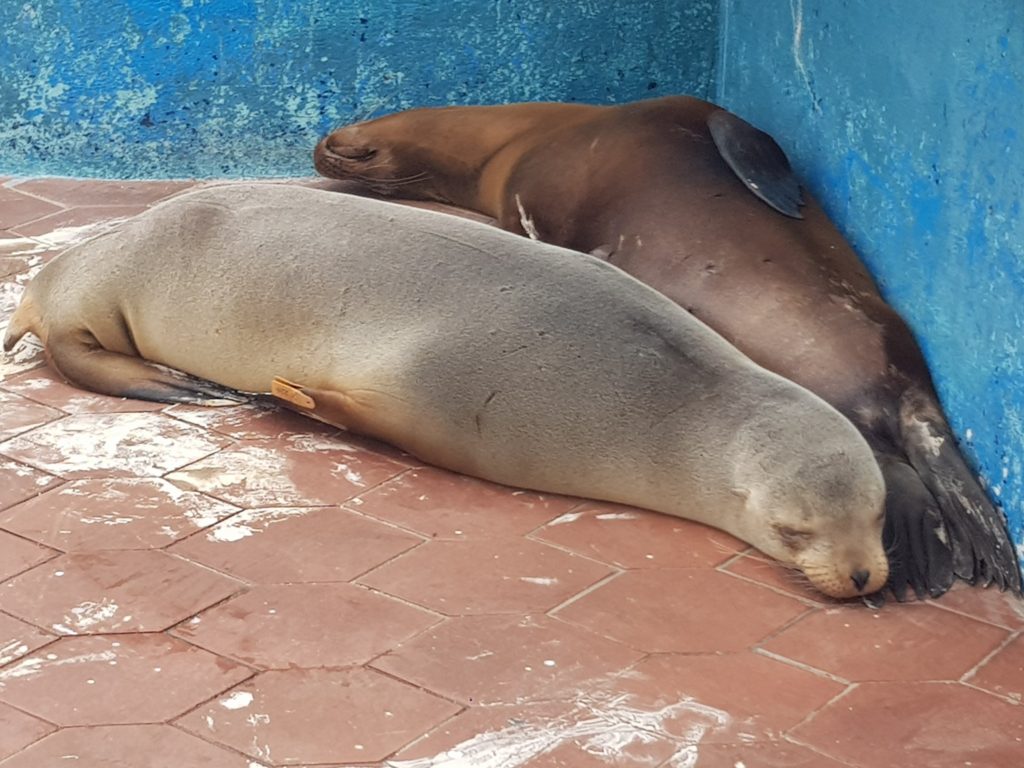
In hindsight, I am glad that I went to the Galapagos. The Galapagos are definitely a unique place, although I expected it to be different. However, I think it’s unlikely that these islands see me ever again.
Is Ecuador worth a trip?
It might be a little unfair to assess Ecuador after coming from Colombia, a country that joined my personal top five of all countries I have been to yet. However, I had generally a good time in Ecuador with some ups and downs.
Ecuador often gets overlooked by travelers. For sure, it’s not easy to attract people when you’re surrounded by heavyweights like Colombia and Peru. That is also one of Ecuador’s strengths though: you won’t find hordes of tourists like on Peru’s Gringo Trail, what makes the travel experience in Ecuador more special in my opinion.
Another strength of Ecuador is its size. Only three South American countries are smaller (Guyana, Uruguay and Suriname), but Ecuador is so diverse that you can experience almost everything South America has to offer there. Ecuador has mountains, volcanoes, jungle, colonial cities, beaches and islands. If someone would ask me where he can see the best of South America with the most possible variety in two weeks, I would suggest traveling through Ecuador.
Unfortunately, I didn’t manage to see all of Ecuador’s highlights. I didn’t have enough time to see Cotopaxi Volcano for example. Another thing I missed out was trekking the Quilotoa Loop and visit the famous Quilotoa Lagoon. There are even more sights and places such as the ancient ruins in Ingapirca or Lake Cuicocha I wasn’t able to see, and I believe that I might would have had more fun while visiting these places instead of killing time on the Galapagos. I would have paid less for sure.
My three highlights in Ecuador were Baños, Quito’s old town and the first two days on the Galapagos. I also had a few lost days, for example the second day in Baños or the forth and fifth day on the Galapagos.
Ecuador was also a country, where I met some weird characters such as Latino Sheldon, the pushy Danish lady or the not so intelligent guy at the hotel reception. That makes the country quite memorable. Will I be coming back? Not in the near future. But who knows, I might end up in Ecuador again and visit the places I didn’t have the chance to visit during my first time.
Find the travel reports of the other countries I’ve visited here!
